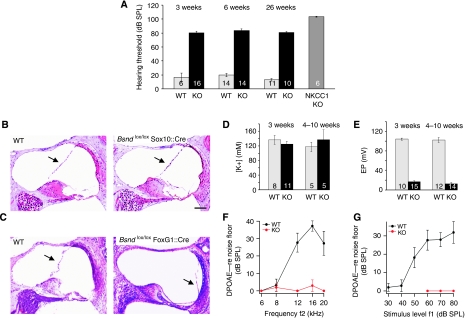Figure 2.
Hearing loss and endolymph of conditional barttin KO mice. (A) Hearing thresholds in 3-, 6- and 26-week-old WT and inner-ear-specific barttin KO mice (Bsndlox/lox Sox10::Cre mice) and 30-week-old Nkcc1−/− mice measured by auditory brainstem responses (ABR). Numbers in columns: number of measured ears; error bars: s.e.m. (B) Unchanged position of Reissner's membrane (arrows) in 1-year-old WT and Bsndlox/lox Sox10::Cre cochleae (HE-stained). At all ages investigated (7 days to 1 year), there was no collapse in Bsndlox/lox Sox10::Cre mice. Scale bar: 100 μm (B and C). (C) HE-stained cochleae from 12-day-old WT and Bsndlox/lox FoxG1::Cre mice (displaying renal salt and fluid loss). Reissner's membrane had collapsed in all 11 Bsndlox/lox FoxG1::Cre mice analysed between P6 and P15. (D) Endolymphatic K+ concentrations and (E) endocochlear potential (EP) of 3 and 4- to 10-week-old WT and Bsndlox/lox Sox10::Cre mice (labelled as ‘KO'). The total number of mice is indicated in each column. (F) Amplitudes of DPOAE (otoacoustic emissions) in 3-week-old Bsndlox/lox Sox10::Cre mice (red, n=4–6) and WT littermates (black, n=6) in response to stimuli at varying frequencies (f1) at 60 dB (WT) or 80 dB (KO) or (G) to 10/12 kHz stimuli at varying levels. Error bars: s.e.m.

